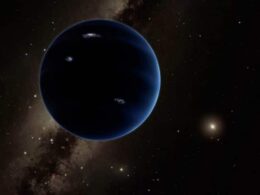Rare chance to see Mare Orientale, site of giant impact on the Moon
The next few mornings offer early risers the chance to spot one of the most dramatic features on the Moon, but one that is usually hidden from view. If you have telescope, you will be able to look side-on at a giant impact basin called Mare Orientale as it appears right on the bright southwestern lunar limb.
This giant bullseye of a feature was blasted out of the Moon’s surface by an enormous asteroid billions of years ago. It has three distinct rings, and is about 930 km (580 miles) across.
Mare means sea, but the seas on the Moon are waterless. They were produced by flows of lava from beneath the surface and released by impacts, which then cooled.
Mare Orientale is known as an impact basin. It lies on the Moon’s far side, which was a complete mystery to astronomers before the space age. That is because the Moon always presents the same face towards Earth. It makes one rotation on its axis for every orbit that its makes of the Earth, and is said to be “tidally locked”.
Only in October 1959, when the Soviet probe Luna 3 flew beyond the Moon and sent back the first blurry pictures, did we find out what the far side looked like.
Incidentally, this lunar far side is sometimes mistakenly known as the dark side of the Moon, a term that has been promoted by a certain well-known Pink Floyd album. In fact, it is no darker than the side that is facing us.
All of the Moon experiences around 14 days of daylight, then 14 days of darkness, as it revolves around the Earth. A complete hemisphere is lit up by the Sun at any one time, so when we see the Moon as a crescent, it means that most of the illuminated hemisphere will be on the far side.
Though the Moon always keeps the same face towards us, it experiences a kind of rocking motion, known as libration, that actually allows us to peek around different parts of the lunar limb at different times.
It means that as much as 59 per cent of the Moon’s surface becomes visible from Earth at some stage or other. Features brought into view will always be seen at a very oblique angle from our viewpoint on the ground. Libration also affects the appearance of some familiar parts of the moon, such as Mare Crisium, the Sea of Crises, a dark plain that looks more compressed and closer to the limb at certain times than at others.
Space probes have given us detailed views of far side features. Many have recorded Mare Orientale, from Apollo missions to robotic probes such as Lunar Reconnaissance Orbiter, and even Galileo as it flew by on its way to Jupiter in the 1990s.
Over the next few days, the Moon’s southwestern limb will be turned slightly towards Earth, allowing us to get an edge-on glimpse of this site of a giant impact on the Moon, and the mountainous rings that surround it. Why not try to see it for yourself?
And check out our own guide to observing craters and other features on the Moon’s surface.
★ Keep up with space news and observing tips. Click here to sign up for alerts to our latest reports. No spam ever – we promise!



